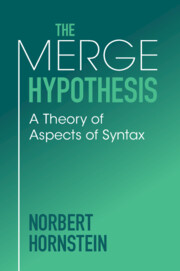Book contents
- The Merge Hypothesis
- The Merge Hypothesis
- Copyright page
- Contents
- Preface
- Abbreviations
- Introduction
- 1 A Whig History of Generative Grammar
- 2 Tools and Particulars
- 3 Adding Labels
- 4 Construal and the Extended Merge Hypothesis (1)
- 5 Construal and the Extended Merge Hypothesis (2)
- 6 A Partial Wrap-Up and Segue
- 7 Labels
- 8 Odds and Ends
- 9 Conclusion
- Bibliography
- Index
2 - Tools and Particulars
Published online by Cambridge University Press: 15 February 2024
- The Merge Hypothesis
- The Merge Hypothesis
- Copyright page
- Contents
- Preface
- Abbreviations
- Introduction
- 1 A Whig History of Generative Grammar
- 2 Tools and Particulars
- 3 Adding Labels
- 4 Construal and the Extended Merge Hypothesis (1)
- 5 Construal and the Extended Merge Hypothesis (2)
- 6 A Partial Wrap-Up and Segue
- 7 Labels
- 8 Odds and Ends
- 9 Conclusion
- Bibliography
- Index
Summary
This chapter identifies the central theoretical-empirical claim of MP, the Merge Hypothesis (MH). It rehearses the motivations for a simple combination operation that takes two objects, combines them in the simplest way possible, and treats the combination so constructed as capable of further combination. I review and explicate the claim that the simplest combination operation would do no more than combine its inputs. This means that the combination operation should not impose a serial order on what it combines, nor should it change the properties of what it combines in any way (as either would involve more than “mere” combination). So construing “simplicity” implies the No Tampering Condition (a principle that forbids changing the structures of the elements combined) and supports the idea that expressions so formed have set-like structure. I further provide a more technical specification of the combination operation by specifying its inductive definition. I then show how to derive a bunch of recognized properties of natural language Gs from this Merge conception of combination and review eight of these, again largely following and elaborating Chomsky’s earlier suggestions.
Keywords
- Type
- Chapter
- Information
- The Merge HypothesisA Theory of Aspects of Syntax, pp. 47 - 74Publisher: Cambridge University PressPrint publication year: 2024

